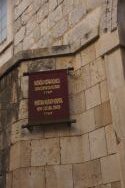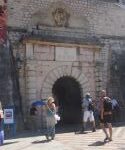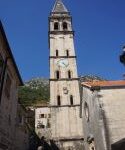August 1, 2013
Kotor
I would be surprised if you’d heard of the country we’re docked in—Montenegro. If you collected stamps from the 19th century, you might have a few in your collection from the short-lived country of Montenegro, which secured its independence from Turkey in 1878, and celebrates that date as one of its “independence days.” It vanished into the Kingdom of Serbs, Croats, and Slovenes after World War I (which ultimately became the Kingdom of Yugoslavia). It stayed with Serbia when Yugoslavia fell apart in 1991, and voted to become independent (our guide said the Montenegrins felt dominated by Serbians) in 2006. That’s the other independence day. So, in some ways, this country of 620,000 people (that’s right!) is a relatively new state. The goal, we were told, is to create a state based on tourism, since Montenegro has sea and mountains,–and, interestingly enough, already uses the Euro (tourism?) although it is not yet a member of the European Union. I’m having a hard time figuring that out!
If you’ve never heard of Kotor, the city where we’re docked, I wouldn’t be surprised at that, either. If you collected stamps when I did as a youth, though, you might have some Italian occupation stamps from 1941-1943 overprinted Kotor. I probably did, but I had no idea where it was. It’s a town at the head of Kotor Bay, (voted one of the most picturesque bays in the  world) with a history dating at least back to the Romans. I went to one of the villages on the bay today, which had a Roman mosaic which has the only known depiction of Hypnos, the Roman god of sleep.
world) with a history dating at least back to the Romans. I went to one of the villages on the bay today, which had a Roman mosaic which has the only known depiction of Hypnos, the Roman god of sleep.
Skip ahead several centuries and Kotor has a heritage rather resembling many of the other ports we’ve visited, though it is closer to the border of East and West. It was included in the Eastern Empire after Diocletian split the Empire. It was then part of the Byzantine Empire (accounting for the Cyrillic alphabet and the Orthodox Churches); as that empire lost control of the Balkans, it became part of various Slavic empires, and for a brief time was an independent republic, thriving on a large merchant fleet, an even larger trade with the interior of the Balkans, and an impregnable location that resisted invasion by sea; the bay narrows to several hundred meters, which was defended by a chain drawn across the bay. For a while, piracy was an important revenue producer (and there’s an interesting document in the maritime museum in which Kotor and the equally pirate based town of Omis, near Split, agreed not to attack each other’s ships; that was in 1167. Honor among thieves?). Like many other towns facing the Turks, Kotor appealed to Venice for protection; because it was wealthy (the
 Venetians calculated the cost benefits of helping others!), the Venetians complied, and Kotor was part of the Venetian Republic until Napoleon ended that. After the Congress of Vienna, Kotor became part of the Austrian empire. And eventually, part of Montenegro.
Venetians calculated the cost benefits of helping others!), the Venetians complied, and Kotor was part of the Venetian Republic until Napoleon ended that. After the Congress of Vienna, Kotor became part of the Austrian empire. And eventually, part of Montenegro.
 If Montenegro is going to offer Kotor as a tourist attraction, its main feature is a well-preserved city, surrounded by an even more well-preserved wall, that at 4.5 kilometers is almost twice the size of Dubrovnik’s. Less hammered by the earthquake of 1667, Kotor can be touted by guides as being older than Dubrovnik. Part of the length, though, comes from the fact that the wall extends 230 meters up the hill behind the city to the fort of St. John’s.
If Montenegro is going to offer Kotor as a tourist attraction, its main feature is a well-preserved city, surrounded by an even more well-preserved wall, that at 4.5 kilometers is almost twice the size of Dubrovnik’s. Less hammered by the earthquake of 1667, Kotor can be touted by guides as being older than Dubrovnik. Part of the length, though, comes from the fact that the wall extends 230 meters up the hill behind the city to the fort of St. John’s.
 Inside the old city, whose gate dates from 1555 (with some additions—a quote from Tito, and the date when the partisans liberated the city from the Germans), who
Inside the old city, whose gate dates from 1555 (with some additions—a quote from Tito, and the date when the partisans liberated the city from the Germans), who replaced the Italian army in 1943, the youngest church dates from 1906—it’s over 100 years old, and the main Cathedral
replaced the Italian army in 1943, the youngest church dates from 1906—it’s over 100 years old, and the main Cathedral  was built in the 12th century. The houses, or rather palaces, were single family residences, with 116 coats of arms of nobles in the local museum. One of the most
was built in the 12th century. The houses, or rather palaces, were single family residences, with 116 coats of arms of nobles in the local museum. One of the most elaborate is the Draco palace—the Dragon house, with its curved windows ala Venice.
elaborate is the Draco palace—the Dragon house, with its curved windows ala Venice.
Well, you know now where Montenegro is, and have heard of Kotor—even if you don’t collect stamps!